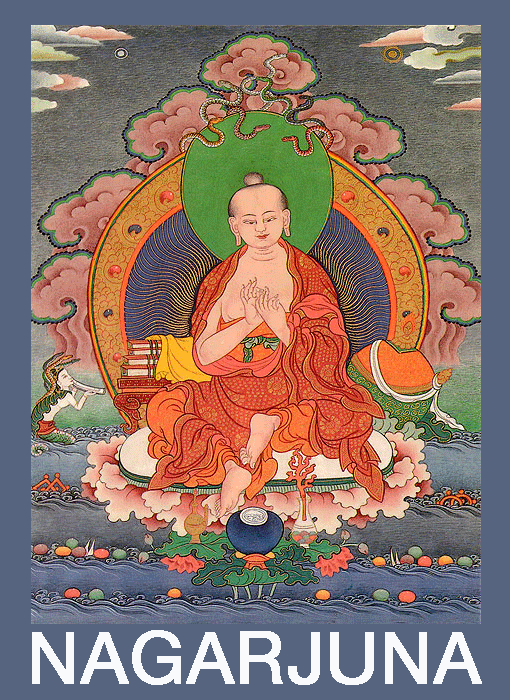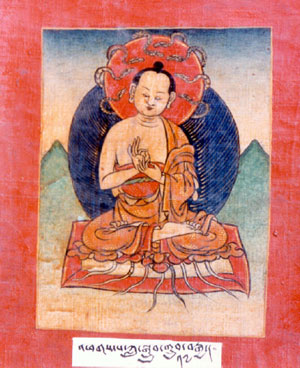
Nagarjuna
Nagarjuna’s enlightenment experience is described in his brief biography, which is found in the Songs of the Eighty-Four Mahasiddhas. The account below is the oral tradition version of Nagarjuna’s song, transmitted to Keith Dowman by Bhakha Rinpoche:
For many years Nagarjuna had been a famous scholar of the first Buddhist university, Nalanda, where he was the penultimate philosophy professor. But hungry for true wisdom instead of book learning, Nagarjuna began propitiating Tara, yearning for the attainment that would give him the power to actually benefit other beings.
The place he sought attainment was Rajgiri, near Vulture’s Peak, a location blessed by Gautama Buddha. There he committed himself to a retreat intent upon connecting with the Twelve Consorts of the Supreme Elementals.
And so they came to challenge him. On the first day, there was an earthquake, which was the trial of the earth element goddess. The second day, a vast flood poured over his retreat spot; the trial of the water element. On the third day, a holocaust of fire burned through the place, the trial by fire. On the fourth day, violent tornadoes and whirlwinds blew, threatening him with a trial by wind. On the fifth day, a shower of weapons fell from the sky, threatening to pierce him. This was the trial of the space element, for weapons like spears knives and arrows kill by creating space in vital organs. On the sixth day, vajra thunderbolts fell on the spot where he sat in retreat, the unity of all the elemental energies together, but he remained unperturbed. On the seventh day, the Elemental Consorts gathered to attack him in person, but they failed to distract him from the great compassionate committment that he had set his heart on.
Defeated, they appeared before him saying, “What do you need? We will provide you with whatever you want.” He asked them for enough food to sustain him during his retreat and spent twelve years at that spot, opening his heart to wisdom. During that time the Elemental Consorts provided him with four handfuls of rice and five handfuls of vegetables each day.
At the end of twelve years, he had one hundred and eight Elemental Consorts under his command, and he had the power to turn mountains into gold, although he was restrained from performing this miracle because of the strife it would have caused the locale.
Dowman writes that Nagarjuna’s alchemical sadhana or meditation practice is called “The Alchemy of Mercury” (Sanskrit: Parada-rasayana). Nagarjuna was one of India’s preeminent rasayana-siddhas, (rasa meaning “gold” and siddha meaning “master of miracles”) the accomplishment of which can be described as the ability to apply the alchemical process at every level of his being. Nagarjuna’s enlightenment reads as a symbolic tale that speaks of his reintegration of the five fundamental elemental energies. The only way these elements could have harmed him was if he was cut off from or in disharmony with the elemental powers that he encountered: for fire cannot burn fire, nor does water drown water, and so on. As he harmonized and integrated the pure elemental energies within his mindstream, the outer appearances of these elements could find nothing to smash, drown, burn, blow apart or explode. And as a result of this alchemical awakening he was able to manifest the outer sign of his realization, the capacity to transform earth and stone into gold.
Nagarjuna’s work was well known in India before the Muslim invasion, which erased most traces of Tantric Buddhism that had not been transmitted via the Silk Road and by other means to practitioners in Nepal, Tibet and elsewhere. Al-buruni, a Muslim traveler and journalist of the eleventh century writes: “A famous representative of the science (of rasayana) was Nagarjuna, born at Fort Daihak, close to Somnath (in Sindh). He used to excel at the art and compiled a book which contains the essence of all literature on that subject and is very rare. He lived a hundred years before our epoch.”





